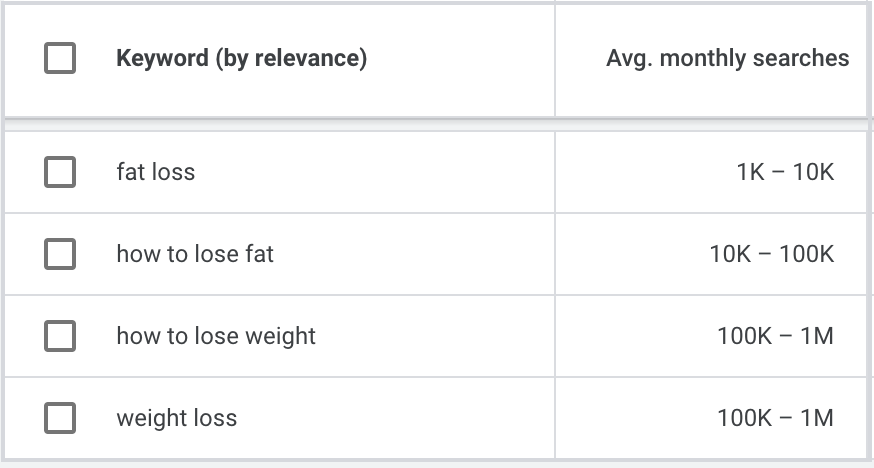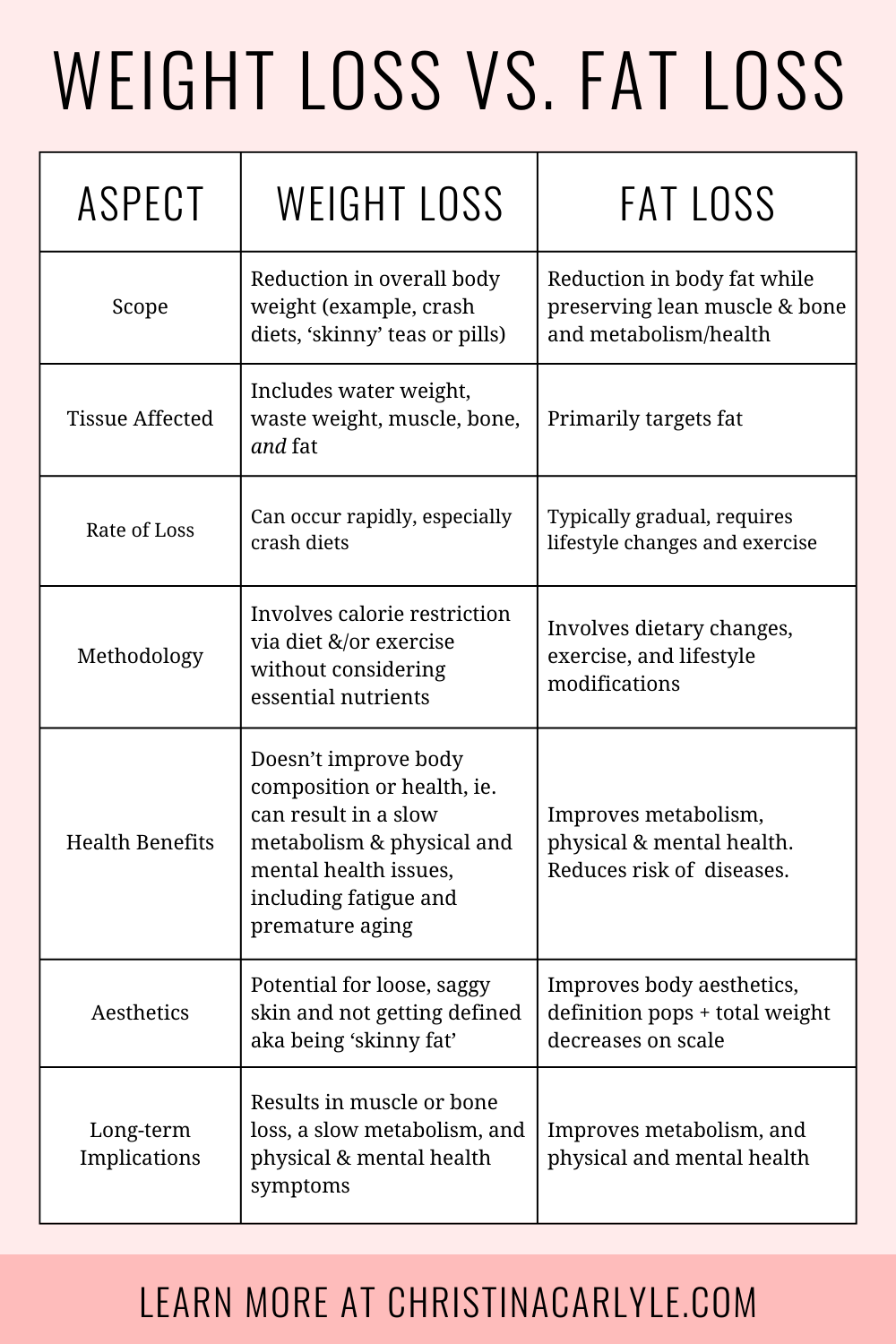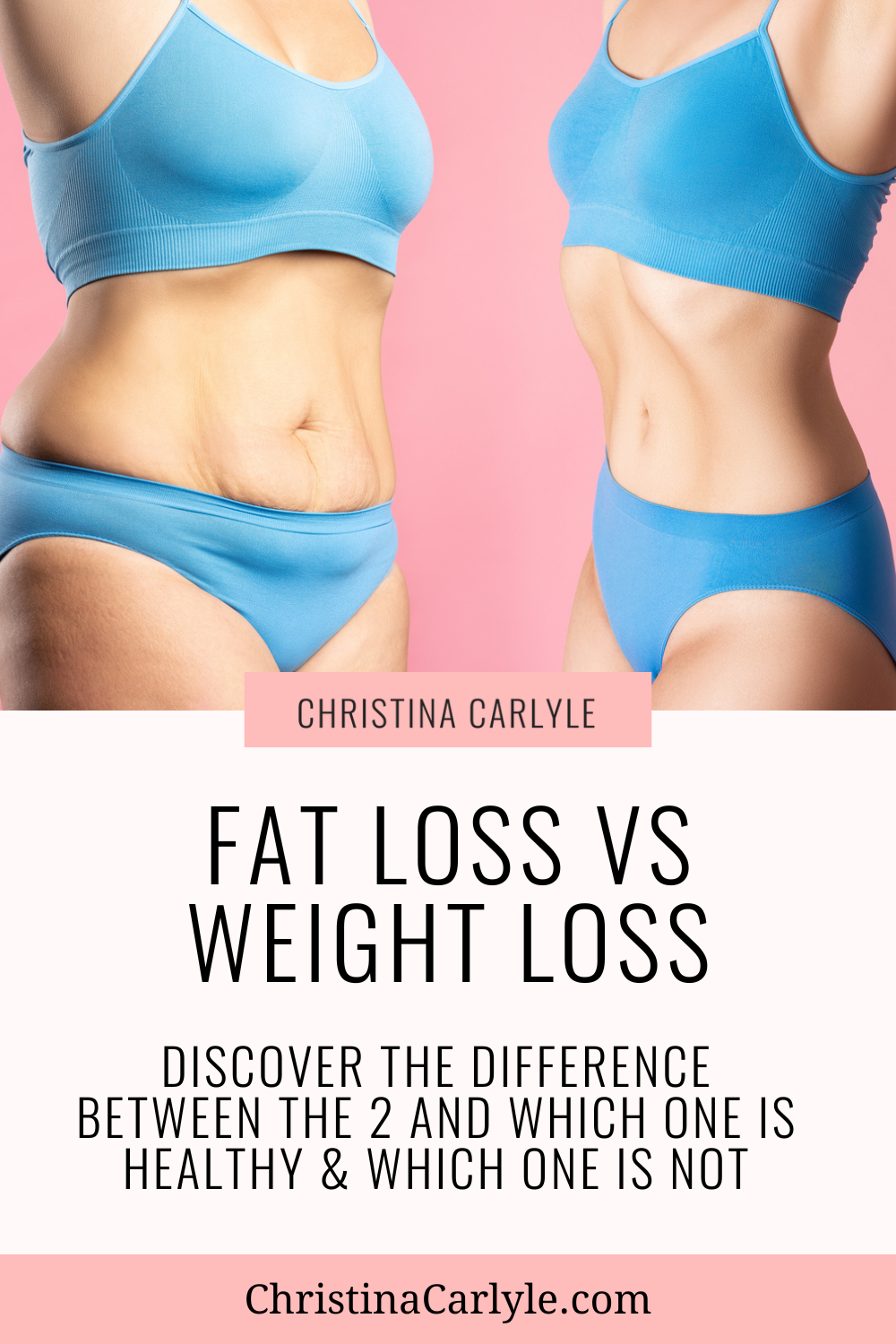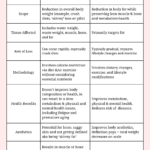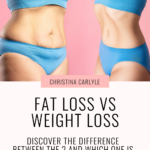Last Updated on March 14, 2024
I know weight loss and fat loss seem like they’re the same… but they’re not.
Weight loss and fat loss are terms often used interchangeably, but they represent very different concepts each with different outcomes.
It’s very common to want to lose weight. In fact, that’s what most people *think* they should be losing… but the goal should always be fat loss. I know I create a lot of content around weight loss… and that’s because that’s what everyone searches for. See? These are monthly search statistics straight out of Google’s keyword tool.
Now obviously for business purposes, it makes sense that I use the right keyword because that’s what everyone is searching for.
BUT now that you’re here I want to clear up some confusion between fat loss and weight loss. Because losing one is great and the other? Not so much! And hint: Weight loss isn’t the ideal option!
So in this post, I’m breaking down fat loss vs. weight loss so you understand the differences between the two and know what mistakes to avoid.
Let’s dig in.
First things first. Let’s define what weight loss is and what fat loss is so you can see the difference.
Weight Loss:
- Weight loss refers to a reduction in overall body weight, which can occur due to various factors such as loss of water weight, waste weight (poop or toxins), muscle mass, bone density, and fat mass. So with a weight loss approach you become a smaller version of yourself.
- When only focusing on ‘weight loss’ long term doesn’t differentiate between the types of tissue being lost, meaning it can include reductions in water weight, muscle mass, bone, and fat mass.
- Examples: Crash Dieting, calorie restriction or calories in versus calories out mentality (eating less, working out more) without considering health or metabolism, the focus on weight loss is always calorie-centric to reduce the number on the scale and get smaller but doesn’t address metabolism or health. Often times the ‘weight loss’ approach creates or worsens physical and mental health symptoms like fatigue, nutrient deficiency, hormone issues, gut health issues, and premature aging.
- Weight loss can occur rapidly, especially through methods like crash diets or severe calorie restriction, but it may not necessarily lead to improved body composition or long-term health benefits. In fact, long term weight loss methods (like a calorie deficit based diet without consideration for nutrients or exercise).
- Losing water and waste weight – when done right (in the short term, i.e. with a cleanse) – reduces inflammation and the toxic load in the body which can improve both physical and mental health, energy and metabolism. When done properly and temporarily (like with my Reset Cleanse), weight loss can result in the number on the scale dropping quickly in a safe way that has benefits (reduces toxic load and inflammatory water weight) and minimizes negative side effects like saggy skin, muscle, and bone loss.
- Long term weight loss (more than 2 weeks) often results in losing muscle or bone mass can cause major issues and slow the metabolism and sets you up for rapid regain. Only focusing on weight loss can set you up to be skinny fat, meaning you become smaller, but because you’re losing muscle mass, you won’t change body composition and the body will appear ‘soft; and giggly instead of toned, lean, and fit.
- Long term weight loss methods (ie. calorie centric approaches without proper nutrient intake or exercise) can result in loose, saggy skin, and physical and mental health issues, like gut health issues, hormone imbalances, nutrient deficiencies, and other metabolic issues.
Pin this post to Pinterest so you’ll have it forever
Fat Loss:
- Fat loss specifically targets the reduction of body fat while preserving lean muscle & bone mass.
- It involves a decrease in the amount of adipose tissue (fat tissue) in the body… meaning you only lose the unhealthy, unsightly fat while preserving muscle that keeps the metabolism running quickly and optimally.
- Fat loss typically occurs gradually and requires a combination of dietary changes, regular exercise, and lifestyle modifications like getting enough rest and using stress management techniques.
- Fat loss improves metabolism resulting in improved appearance (the number on the scale drops and definition pops), and improved physical and mental health.
- Focusing on fat loss improves body composition because you maintain/build lean muscle, but only lose fat. This results in seeing the number on the scale drop and muscle definition will pop resulting in a toned, lean, fit appearance.
- Unlike weight loss, fat loss is generally considered more beneficial for health and body composition because it helps reduce the risk of obesity-related diseases and improves body aesthetics in a healthy way.
In terms of aesthetics, weight loss refers to a decrease in overall body weight, fat loss specifically targets the reduction of body fat while preserving muscle mass.
Fat loss is more desirable for health and aesthetics compared to weight loss because weight loss can cause physical and mental health issues and can slow metabolism setting you up for rapid regain and worsening symptoms.
HOW TO LOSE FAT (AND WEIGHT) IN A HEALTHY WAY
The best approach to getting healthy and fit is to combine a meal plan with workouts that will boost metabolism and burn fat. Hint: This is what I do when I work with my clients.
- When you get the right combinations of nutrients and calories at every meal you can boost metabolism and burn fat.
- When you do the right combinations of cardio and weight training workouts you can boost metabolism and burn fat.
- By combining the right nutrition with workouts you get the most metabolic and fat burning benefits. By doing both you’ll not only burn fat and get fit but you’ll also be able to get/stay healthy (both physically & mentally).
- Fat loss – done right – always results in improving metabolism and immunity – and a reduction in not only unwanted, unsightly body fat, but also a reduction in physical and mental health symptoms like bloating, pain, fatigue, cravings, inflammation, irregularity, headaches, etc.
BUT – there are a lot of fat loss approaches (like macro counting & more aggressive workouts like lifting heavy, high impact, and long duration training sessions) that can also cause health issues like hormone imbalances, nutrient deficiency (micronutrients), fatigue, premature aging, etc.
The key to getting the best possible results, i.e. fat loss while improving metabolism and immunity – is to make sure you’re giving the metabolism everything is needs to function properly and using a comprehensive nutrition and training program.
When I work with clients I do this by reducing toxin and inflammatory waste weight and fat first… because reducing toxins and inflammation make it easier to burn fat and boost metabolism moving forward. Plus, it gets the number on the scale to drop quickly in a healthy way, which improves energy, mood, and immunity. Doing this is EXTREMELY motivating and sets my clients up for success and get better results moving forward.
After, I implement fat loss protocols that include both nutrition and training that will prevent toxins and inflammation (ie prevents waste and water weight) while simultaneously helping them burn fat and boost metabolism and immunity. That’s how I get people happy, healthy, and fit quickly and naturally. Working this way helps you can get continuous results and prevent/reverse symptoms, so you can look and feel your best.
If you’re interested in learning more about my unique approach, check out this free Metabolic Assessment and Training.
Your Coach & Biggest Cheerleader,
![]()


